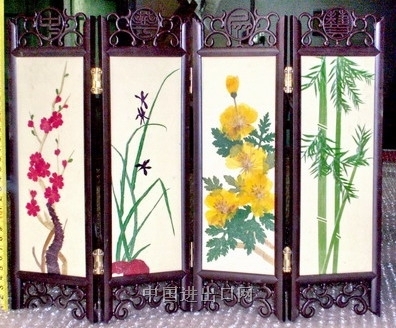more>>More News
- National Day
- ways to integrate into Chinese style life
- Should they be in the same university with me?!!
- Chinese Ping Pang Legend: the Sun Will Never Set
- A Glance of those Funny University Associations
- mahjong----The game of a brand new sexy
- Magpie Festival
- Park Shares Zongzi for Dragon Boat Festival
- Yue Fei —— Great Hero
- Mei Lanfang——Master of Peking Opera
The Hidden Beauty of Chinese "Pingfeng"
By admin on 2014-12-22
The elegant Chinese pingfeng (folding screen) is an ancient invention that is an essential part of traditional Chinese furniture.

The earliest common use of the pingfeng dates back to the Han Dynasty (206 BC-AD 220). The term pingfeng means protection from wind,which suggests the original purpose of the pingfeng was to block drafts.
As time passed, this furniture was made in a wide range of sizes, from extremely large, oversized folding screens that were used in spacious palaces, to miniature decorative screens that could comfortably fit on a tabletop.
Folding screens used as room dividers was constructed from several panels attached to each other. The most popular room dividers in 7th century China were six or eight- paneled folding screens.
Chinese folding screens often feature a dragon motif. The dragon is probably one of the most familiar Chinese designs. It is the leader of all animals, and a symbol of masculinity, light, growth and life-giving water. As a king of the animals, it also represents nobility and royalty.
Beautiful male and female peacocks were also depicted on pingfeng panels. In ancient times the peacock was known to the Chinese only by reputation, but as the empire extended southward into tropical climates, interest in this spectacularly colored bird exploded. According to legends that originated in India, these birds eat snakes, especially of the poisonous variety, can avert natural disasters, and are a symbol of immortality. The peacock’s legendary combination of strength and beauty led to its extreme popularity as a decorative subject.
Pingfengs made from several joined panels also bear other decorative paintings and calligraphy.
A ‘pingfeng’ story
As mentioned above, an elegant Chinese pingfeng, or screen, was not a purely decorative piece of furniture in an old Chinese home. The screen, which would always be solid enough not to be seen through, would double as a thing of beauty and a hiding place.
In feudal China, the unmarried young woman of a rich family was not supposed to see or be seen by men other than her father, brothers or very close male cousins.
When a potential suitor paid a visit, however, the daughter of the house might take a peek at him from a screen behind which she would be completely concealed.
Her father would discuss literature with the young man and ask him to compose an impromptu poem. If the composition of the poem - and the man's good looks - impressed the young woman and her father, she might agree to take him as a husband.
Old ‘pingfengs’ in modern homes
Today the pingfeng is back in vogue for its distinctive Eastern elegance, as well as its practical function as an exotic piece of furniture that can act as a moving wall or divider, and create space in a room.
Well-chosen oriental furniture can be the perfect match for the simple and light colors of modern sofas, walls and cushions.
In a large sitting room or bedroom you can use a pingfeng to divide the area. Old fretwork wooden windows can also be put together to form a screen.
The ancient Chinese pingfeng can add character and defining style to even the most modern room.
- Contact Us
-
Tel:
0086-571-88165708
0086-571-88165512E-mail:
admission@cuecc.com
- About Us
- Who We Are What we do Why CUECC How to Apply
- Address
- Study in China TESOL in China
Hangzhou Jiaoyu Science and Technology Co.LTD.
Copyright 2003-2024, All rights reserved




 Chinese
Chinese
 English
English
 Korean
Korean
 Japanese
Japanese
 French
French
 Russian
Russian
 Vietnamese
Vietnamese
